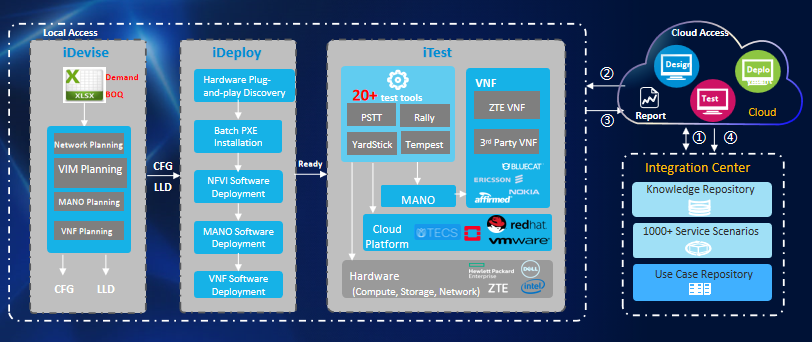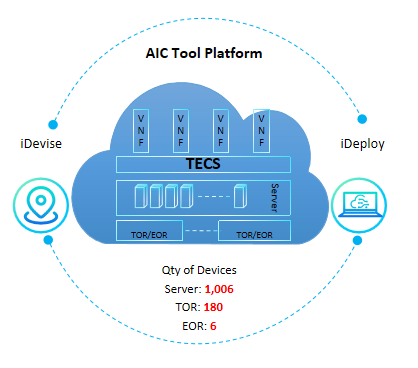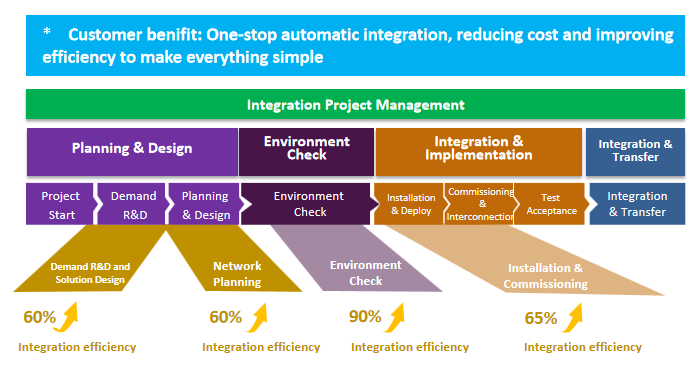On June 6, 2019, the Ministry of Industry and Information Technology (MIIT) issued 5G licenses to China Telecom, China Mobile, China Unicom, and China Broadcasting Network, marking the beginning of the first year of 5G commercial use in China. Because NFV networks are the core foundation for the development of new 5G services in the future, major telcos have begun the large-scale deployment and construction of NFV networks. However, they have to face lots of problems, such as the large scale of resource pools, the large number of servers, and complicated and difficult integration of cloud platforms and applications. Telcos need a more intelligent, simpler, and easier-to-use end-to-end (E2E) automated tool platform to support the deployment of NFV networks, involving the planning and design in the early stage, and deployment, test, and acceptance of software and hardware in the post-period. Therefore, it can reduce the complexity of network design and improve design accuracy and overall deployment efficiency.
AIC: A New-Generation E2E Virtualized Automatic Integration Tool Platform
The Automatic Integration Center (AIC) is a new generation of E2E virtualized automatic integration tool platform developed by ZTE. It is a miniature of ZTE's practical technology innovation that leads the rapid development of intelligence and automation in the telecom field. From manual integration at the beginning, to simple integration with tool platforms, and then to E2E automatic integration, the AIC tool platform has been increasingly matured and can be applied. At present, the AIC tool platform is capable of supporting the construction of NFV networks involving E2E full-scenario automation capabilities such as planning, design, installation, deployment, test, and verification.
ZTE AIC tool platform consists of three suites: iDevise, iDeploy and iTest.

Figure 1 ZTE AIC Tool Platform
iDevise network planning suite: According to the specific project requirements and information, you can pre-define configuration templates of hardware, virtualization layer, MANO and VNF to plan and design the virtualization network environment required for the deployment of VNFs. LLD files are automatically generated and can be imported into the iDeploy component.
iDeploy installation and deployment suite: It supports one-click automatic installation and E2E installation without manual intervention, involving hardware configuration, VIM, MANO system, VNF and 5GC NF.
iTest automatic test suite: It supports downloading cloud test cases, automatically testing local test cases, and integrating and verifying the virtualization layer and VNFs in terms of function, performance and reliability to accelerate service onboarding.
On November 1, 2019, ZTE won the bid for China Mobile's 2019 NFV network equipment procurement project (phase 1) in 12 provinces of 6 regions. In the North China region, China Mobile Hebei Baoding branch was the first station of the project. The main task was to complete the end-to-end integration of 1,006 DC servers on the basis of the previous hardware integration. In this project, the AIC tool platform successfully supported implementing the ultra-large and automated integration planning and on-site deployment.

Figure 2 AIC Facilitates the Large-Scale Automatic Deployment of NFV Network
The AIC iDevise enables to output, the cloud platform LLD within 4 days, improving the overall efficiency significantly.
To integrate the virtualization layer cloud platforms, you must design the virtual layer cloud platform LLD. For a large-capacity DC with 1,006 servers, if the traditional LLD design mode is adopted, the designer will face thousands of complicated parameters in the LLD. It usually takes a long time to design and has a very high human error rate.
Based on the previous hardware integration design solution, China Mobile’s specifications and software integration HLD information, engineers use the AIC iDevise automatic configuration tool platform. Only a few necessary parameters need to be input, and the remaining parameters are automatically generated by the tool platform according to the built-in logic relationship. This greatly reduces the probability of human errors and the design difficulty, and standardizes the design output.
For data centers of the same size, using the iDevise tool platform can shorten the overall design period from 2-3 weeks to about 4 days,, and the on-site inspection results are correct and reliable.
The AIC automatic check tool helps to complete large-scale server scanning, inspection and troubleshooting quickly, accurately, and efficiently within four hours.
Before starting software debugging for the virtualization layer cloud platform, the project team must check the hardware environment of the entire resource pool. Before that, 1,006 servers have been installed in the cabinet, connected, powered on and configured with parameters.
The project team first uses the built-in AIC server configuration check tool iCheck to scan and check 1,006 servers rapidly. The tool accurately detects incorrect configurations in the current environment, including RAID configuration errors, BIOS parameter configuration errors, NIC slot errors, network connection errors, loose network cables, incorrect switch configurations, and DHCP conflicts. For misconfigured parameters, engineers rapidly reconfirm and modify configuration parameters and upgrade the firmware. It takes only four hours.
If this tool is not used, you need to manually check the hardware. It may take at least one week to complete the above tasks. Obviously, the application of the AIC tool platform has greatly improved work efficiency and made pioneering contributions to the improvement of integration efficiency.
The AIC iDeploy automatic deployment tool facilitates the rapid end-to-end deployment.
For 1,006 servers, if the virtual layer cloud platform is deployed in traditional manual mode, there will be many installation steps, a long installation period and error prone. According to the previous work experience, it usually takes four engineers to complete the large-scale deployment in 2-3 weeks. With the support of the iDeploy automatic deployment tool, the project team implements zero intervention throughout the whole process. It takes only 14 hours to complete the virtualization layer installation and commissioning of all 1,006 servers in the resource pool.
With the AIC tool, the subsequent deployment duration of NFVO+ is within 3.5-4 hours, the deployment duration of VNFM is 50 minutes, the deployment duration of a single EPC VNF is 45-55 minutes, and all operations are passed at one time. Compared with the traditional manual deployment mode, the overall deployment efficiency is increased by more than 50%, and the overall efficiency is promoted with the increase in the number of deployed VNFs.
The AIC tool guarantees the successful deployment of China Mobile Hebei Baoding branch in North China. In other five regions, the AIC tool continuously improves efficiency and speed, and helps to complete end-to-end deployment quickly.
In terms of the overall effect of multiple projects at home and abroad, the AIC tool platform can greatly improve the efficiency of each step of project integration. In the planning and design phase, the average efficiency is increased by more than 60%. In the hardware environment check phase, the average efficiency is increased by more than 90%. In the cloud platform and service deployment implementation phase, the average efficiency is increased by more than 65%.

Figure 3 One-Stop Automatic Integration Management
The successful application of the AIC tool platform in China Mobile not only proves its high efficiency in end-to-end and automatic integration under the ultra-large-scale server deployment scenario, but also proves that intelligence and automation is necessary for solving integration problems with high efficiency and accuracy in the face of increasingly complicated integration contents and integration scenarios in the future. With the continuous development and application of automation technologies, the AIC tool platform will continue to adapt to the times and strive for changes in the future. At the same time, ZTE is willing to work with more partners to jointly promote intelligent upgrade of the integration industry, and help telcos implement efficient cloudified network transformation.
ZTE supports AI with full-stack IT offering
5GC Green Engine Solution to Enable Green Internet of Everything in the Dual-Carbon Era
5GC Private Network 2.0 Empowerment and Efficiency Improvement Boosts High-Quality Development of the Industry
5G Empowers Intelligent Mining for High-quality Development of Shaanxi Coal Caojiatan Mining
ZTE and China Mobile embrace digitalization for biodiversity conservation in Panda Reserve
Three Aspects Contribute to ZTE’s Remarkable Breakthroughs in Advanced G4X Server
How 5G Private Networks Are Poised to Transform Enterprises Worldwide: All Scenario Private 5G Helps Operators to Realize Private 5G as a Service
ZTE’s commitment to servers generates robust growth of up to 60 times in past 8 years
ZTE eyes top 5 global server market share
Full-Scenario One-Stop 5G Private Network for Vertical Industries

